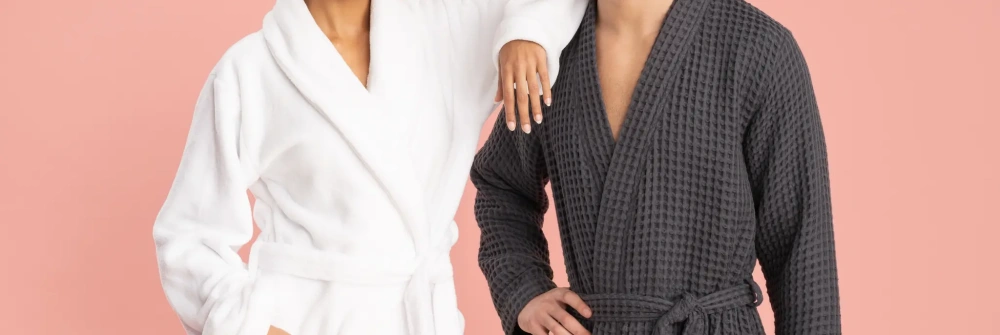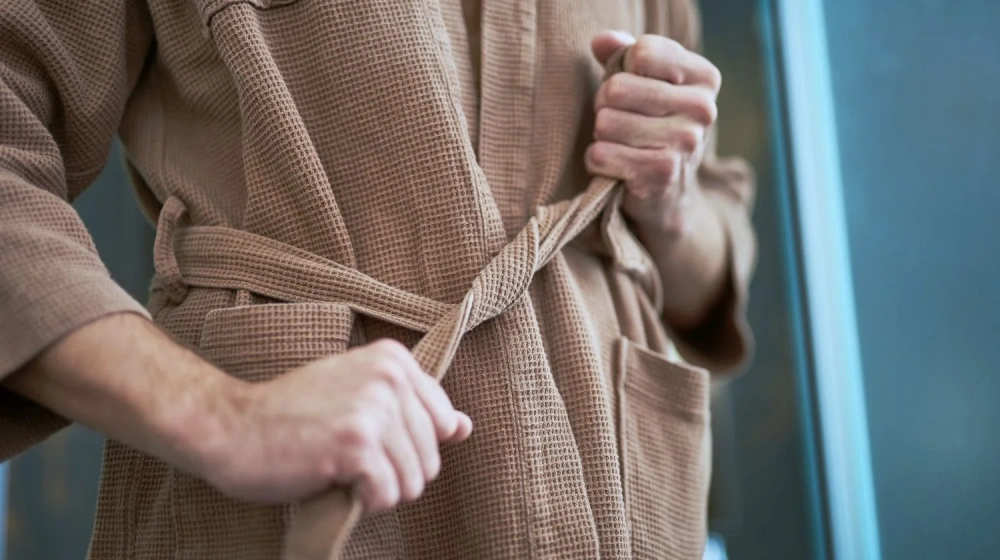Tying a robe with inside strings may seem simple, but doing it right ensures your robe stays securely fastened while maintaining a neat, polished look. Whether you’re lounging at home or getting ready for the day, knowing how to tie a robe with inside string will make all the difference in comfort and style.
In this guide, we’ll walk you through the steps to tie your robe with precision. From understanding the inside string’s function to securing it just right, you’ll learn how to effortlessly keep your robe in place every time.
What is the String Inside a Robe For?

The inside string in your robe serves a simple but essential function—it keeps your robe securely in place without needing a traditional belt. This string is sewn into the robe’s interior, allowing you to tie it snugly around your waist to hold the robe together. It offers a convenient, minimalist solution for keeping your robe closed while providing comfort and flexibility throughout the day.
Unlike traditional belts that loop around the outside of the robe and require extra adjustments, the inside string is discreet and unobtrusive. It’s designed to be easy to tie, offering a smooth, clean look. The inside string ensures a more streamlined fit, perfect for those who appreciate a functional yet subtle design in their loungewear.
Where Does the String in a Robe Go?
When tying the string in your robe, you’ll notice that the strings on the left and right sides cross over each other. The string on the left should go over the top of the one on the right. This crossing method helps secure the robe in place and prevents it from slipping open.
After crossing the strings, bring one end of the left string under the right tie and pull both ends tightly. One end should now be on the right side, while the other comes out on the left. This creates a firm knot that keeps your robe securely fastened, ensuring comfort throughout wear.
How Many Strings Does a Robe Have?
Most robes come with two strings: one on the left side and one on the right. These strings are designed to help secure the robe around your body.
Each side typically has two string options, one placed higher than the other for adjustable fit. While some robes may include additional decorative strings for style, the functional design always revolves around two primary strings that help you tie the robe comfortably and securely.
Do All Robes Have Strings?

While most robes feature strings to help secure them, not all robes include this option. Some robes may use alternative fastening methods like Velcro straps, buttons, or loop belts to keep the robe in place. These alternatives can offer a more secure fit or a different style, depending on your preference. So, while strings are common, they are not a universal feature for every robe type.
What is the Minimum Width of Rope Required for Use on a Robe?
When selecting rope for a robe, the minimum width typically falls between a quarter inch to half an inch. This range provides enough strength and flexibility for secure fastening while maintaining comfort.
However, if you prefer a more substantial or delicate feel, you can adjust the width slightly. Just ensure that the rope is not too thin, as this could affect its durability and effectiveness in holding the robe in place.
What is the Purpose of the Extra String on the Inside of the Left Side of the Robe?
The extra string inside the left side of the robe serves as a backup for the exterior strings. It helps secure the robe and keeps it from accidentally opening, especially if the outside strings become loose. You’ll tie this string first, ensuring that the robe stays snug against your body, even if the outer tie loosens. It offers added security and ensures your robe stays properly closed throughout wear.
When you tie the robe’s outside strings, remember to use the inside string first. This inner tie helps hold the robe in place, preventing it from shifting or falling open. If you ever feel that the outer strings aren’t secure enough, this additional string will prevent any wardrobe mishaps, keeping the robe intact and comfortable.
How to Tie a Robe With Inside String: Step by Step Guide

Tying a robe with the inside string can seem tricky at first, but once you get the hang of it, it’s a simple process that ensures your robe stays secure and comfortable. Here’s a step-by-step guide to help you tie your robe the right way.
1. Locate the Inside Strings
Find the inside string in your robe by looking for the small loops or holes along the inside seam. Ensure that the string is not tangled or stuck in the fabric. Gently pull the string out to avoid any snags. You’ll typically find it around the waist area, positioned neatly to help secure the robe.
2. Adjust the Robe for Fit
Put on the robe and adjust it so it fits comfortably around your body. Make sure it aligns with your waist or chest depending on your preference. Ensure that the robe feels balanced and comfortable, with both sides even. You want the robe to sit properly before tying the inside string to avoid any discomfort later.
3. Cross the Inside String Across Your Body
Once the robe is positioned correctly, take the left side string and cross it over to the right side of your body. Do the same with the right string, crossing it over to the left. The crossing action helps keep the robe securely in place and ensures that it won’t slip open. Make sure to do this gently for comfort and security.
4. Tie the Inside Strings
Now it’s time to tie the knot. Take both ends of the crossed strings and tie them into a secure knot. You can choose a simple knot or a square knot, depending on your preference. The key is to tie it firmly enough to hold the robe in place but not too tight that it feels restrictive. This knot will hold the robe closed and in place throughout the day or night.
5. Check for Security and Comfort
Once you’ve tied the knot, give it a little tug to make sure it’s secure. Adjust the knot if it feels too loose or too tight. You want the robe to stay closed but not feel constricting. The strings should be tight enough to prevent the robe from opening but comfortable enough to move around in without restriction.
Common Mistakes to Avoid
When tying a robe with an inside string, it’s easy to make a few common mistakes. Avoiding these will ensure your robe stays secure, comfortable, and in place all day or night. Here’s what to watch out for:
1. Tying Too Loose
If the knot is too loose, your robe will likely open unexpectedly. This can cause discomfort and leave you constantly adjusting your robe. A loose knot also risks the robe shifting or becoming untied entirely. Always make sure the knot is snug enough to stay put but not tight enough to restrict movement.
2. Over-tightening the Inside String
Pulling the inside string too tight can cause discomfort and restrict your movements. It may leave marks on your skin or make it harder to breathe easily. Over-tightening also puts unnecessary strain on the fabric, which can lead to wear and tear. Be mindful of finding a balance between security and comfort when tying your robe.
3. Ignoring the Inside String’s Role
The inside string helps keep your robe in place without relying on an external belt or tie. Ignoring this feature and leaving it untied can lead to the robe slipping open or becoming misaligned. The inside string ensures that the robe stays securely wrapped around your body. Make sure to use it as intended for the best fit and function.
Tips for Keeping Inside Strings in Good Condition
Taking proper care of these strings ensures your robe stays functional and looking great for a long time. Here are some helpful tips to help you maintain those inner strings:
Preventing Inside String Tangles and Frays
Always make sure the inside strings are properly aligned before tying your robe. Gently pull the strings without excessive force, and avoid wrapping them around other items when storing the robe. After use, untie the strings carefully and store them flat. This simple habit will prevent the strings from getting knotted or frayed over time.
Washing and Drying Robes with Inside Strings
When washing your robe, remember to tie the inside strings loosely or place the robe in a mesh laundry bag. Use cold water and a gentle detergent to avoid unnecessary stress on the fabric. For drying, hang your robe to air dry. Avoid putting it in the dryer, as high heat can weaken the strings and cause them to shrink or become frayed. Proper washing and drying will help maintain the integrity of the inside strings.
Maintaining Inside Strings for Longevity
Avoid over-tightening them when tying the robe. If you notice any wear or fraying, consider reinforcing the strings with a few stitches or replacing them if needed. Regularly check the condition of the inside strings and make adjustments when necessary. Taking these small steps will extend the lifespan of your robe and its strings, ensuring they continue to work smoothly.
Is It Possible to Tie a Robe Without a String?
Yes, it is possible to tie a robe without using the string. While most robes come with strings to keep them closed, they aren’t the only option. Some robes, especially historic ones, use hooks and eyes instead of strings for closure. These serve the same purpose, keeping the robe secure.
In modern robes, alternatives like Velcro straps, buttons, or adjustable loops can also hold the robe together. These options work well, particularly for silk robes, which are slippery and prone to coming undone. So, even without strings, you can keep your robe securely closed with other methods.
Conclusion
Tying a robe with the inside string may seem simple, but it ensures a secure and comfortable fit. By following the steps to locate, cross, and tie the inside strings, you’ll keep your robe snug and well-positioned. A properly tied robe prevents it from slipping open, ensuring your privacy and comfort throughout the day.
Remember, taking the time to tie your robe correctly adds durability and longevity. If you’re looking for high-quality robes that prioritize both style and function, be sure to check out the selection at Friendtex for your next wardrobe upgrade.


